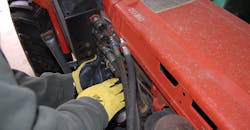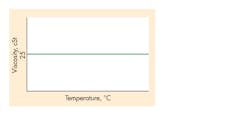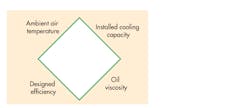The Four Pillars of Hydraulic Machine Efficiency
Most readers of this column are well aware that the viscosity of a hydrocarbon-based hydraulic fluid is inversely proportional to temperature. As temperature increases, fluid viscosity decreases and vice versa. This is not an ideal situation for several reasons. In fact, the ideal hydraulic fluid would have a viscosity index (the change in a fluid’s viscosity relative to temperature) represented by a horizontal line intercepting the Y axis at 25 centiStokes.
This temperature-viscosity shows that an ideal hydraulic fluid would exhibit no change in viscosity regardless of temperature.
Unfortunately, no such fluid exists for hydraulic machine efficiency and longevity. And it’s unlikely such a fluid will be developed in my lifetime. But if such a fluid was developed and patented, its creator would hold the key to a gold mine. For now, we have multi-grade hydraulic oil. These fluids have a high viscosity index, so their viscosity is less sensitive to changes in temperature than a monograde oil.
Unintended Consequences
Fluid viscosity is one of the factors that determines whether full-film lubrication is achieved and maintained. If load and surface speed remain constant, but elevated operating temperature causes viscosity to fall below that required to maintain a hydrodynamic film, boundary lubrication occurs; this creates creating the possibility of friction and adhesive wear.
On the other hand, there is a viscosity range where fluid friction, mechanical friction, and volumetric losses are optimal for hydraulic system performance. This is the viscosity range where the hydraulic system will operate most efficiently: the highest ratio of output power to input power.
To illustrate the above point, consider this example: In the quest for improved fuel consumption, the manufacturer of an engine-powered, mobile hydraulic machine replaced its fixed-displacement pump powering the machine’s attachment with a variable-displacement unit. The ground drive on the machine already used a variable-displacement piston pump (hydrostatic transmission), so upgrading the attachment’s hydraulic circuit to a more-efficient configuration seemed logical progression by the machine’s design engineers.
When this modification was tested, the engineers were shocked to find that fuel consumption had actually increased by 12 to 15%! Upon analysis, the hike in fuel consumption was attributed to an increase in oil viscosity brought about by a 30°C drop in operating oil temperature. In other words, the “thicker” oil had resulted in extra drag on the hydrostatic transmission powering the ground-drive, causing the machine to use more fuel.
The machine used a two-section, combination heat-exchanger for both hydraulic oil and engine coolant. Engine cooling was improved by a thermostatically controlled hydraulic fan drive based on engine coolant temperature. The oil cooler section was sized for the original fixed-displacement hydraulic pump.
The drawback with this arrangement is, due to engine cooling being thermostatically controlled and the hydraulic system not, air flow through the combined heat-exchanger depends entirely on engine temperature. This means the reduction in heat-load from replacing the fixed-displacement pump with a variable-displacement unit resulted in a significant reduction in hydraulic oil temperature—which is normally a good thing!
The engineers blocked off most of the hydraulic oil section of the cooler and ran the test again. This returned fuel consumption to the original level, but no significant improvement was seen.
It was concluded that the modification tested could result in a small cost saving with respect to a reduction in size of the oil cooler. But with fuel consumption being more important than any modest saving in cooling capacity, the idea of paying more for a pump that resulted in the oil being kept at a lower operating temperature—but increased fuel consumption—was irreconcilable to the machine’s engineers.
Lesson Learned
This story illustrates the impact hydraulic oil temperature (and therefore, viscosity) can have on fuel consumption. To recap the key points:
- The heat-load on the hydraulic system was reduced (efficiency increased) by replacing a fixed pump with a variable displacement unit;
- This resulted in a significant drop in operating hydraulic oil temperature;
- The resultant increase in hydraulic oil viscosity increased fuel consumption by a meaningful amount.
In other words, if your hydraulic oil is too thick, you’ll pay for it at the fuel pump or electricity meter. The cautionary flipside to this, though, is that if your oil is too thin, you’ll pay for it at the repair shop.
Assuming this trial was conducted at the same ambient temperature for both pump options, a 30° C (54° F) drop in hydraulic oil temperature is quite remarkable. This may, in part, be explained by the combination heat exchanger installed on the machine. As hydraulic oil viscosity increases, the engine works harder (burns more fuel), so the cooling fan (controlled by engine temperature) runs harder. This means more heat is dissipated from the hydraulic oil and, therefore, hydraulic oil viscosity increases further. It’s a viscous circle.
Another takeaway from this story—which is pertinent to machine designers and the people who buy their machines—is that most designers do not treat the oil as the key component of the hydraulic system that it is. The hydraulic oil’s viscosity, viscosity index, or the optimum viscosity number for the hydraulic components in the system apparently were not considered during the test. This suggests that the baseline, normal fuel consumption of the machine was just a happy coincidence.
Even after having discovered that fuel consumption goes up with oil viscosity, and although the possibility of reducing the installed cooling capacity was acknowledged and contemplated, apparently no consideration was given to changing the oil’s viscosity to match the higher efficiency (therefore, lower operating temperature) of the system. Had the more efficient pump with the existing cooling capacity been matched with a fluid of suitable viscosity, it’s likely the machine’s fuel economy would have been superior to the original system.
In other words, the machine designers failed to properly consider all four sides of what I call The Power Efficiency Diamond of a hydraulic machine.
The Power-Efficiency Diamond
Power efficiency means the ratio of power out to power in. Ninety kW out from 100 kW in is an efficiency of 90%. Ninety kW out from 110 kW in is an efficiency of 82%. And 90 kW out from 120 kW in is an efficiency of 75%. Note that in all three cases, output power remains the same: 90 kW. It’s just that the input power—therefore, fuel or electricity consumption of the prime mover required to get it—keeps going up!
Quadrants of the Power Efficiency Diamond of a hydraulic machine are all interrelated. Changing any one affects the symmetry of the diamond.
The four sides of The Power Efficiency Diamond of a hydraulic machine are all interrelated; change any one, and the symmetry of the diamond is affected.
Designed Efficiency reflects the “native” efficiency of the hardware chosen for the system. This hardware includes the number of power-wasting devices present, such as proportional valves, flow controls, and pressure-reducing valves. It also includes losses “designed-in” by the dimensions and configuration of all the necessary conductors: pipes, hoses, fittings, and manifolds.
On the opposite side of the diamond, Installed Cooling Capacity, as a percentage of continuous input power, should reflect the designed or native efficiency of the hydraulic system. In other words, the lower the native efficiency, the greater the installed cooling capacity.
Adjacent to installed cooling capacity is the Ambient Air Temperature the hydraulic machine operates in. This directly influences the hydraulic system’s operating oil temperature, which largely determines Oil Viscosity, completing the Power Efficiency Diamond.
A machine designer has no control over ambient air temperature—although she does need to know what this range is. But she does (or at least should) determine the other three variables; design efficiency, installed cooling capacity, and oil viscosity. As the pictorial representation of the Power Efficiency Diamond illustrates (and the above case study demonstrates), no one of these variables can be considered in isolation.
Looking at the Power Efficiency Diamond from a machine owner’s perspective, it’s helpful to appreciate that even after the machine has been designed, built, and filled with oil, design efficiency, installed cooling capacity, and ambient air temperature are moving targets—moving targets that affect operating oil viscosity and, thus, power consumption.
The possibility of variation in ambient air temperature, particularly if the machine is moved between locations with different climatic conditions, is fairly obvious. And although design efficiency doesn’t vary, actual operating efficiency typically deteriorates over time from wear and tear. Similarly, although installed cooling capacity doesn’t change over time as a percentage of input power, the effectiveness of it can be reduced by wear and tear of cooling circuit components and—in the case of air-blast heat exchangers—variation in ambient air temperature and altitude.
So getting a hydraulic machine into its power efficiency “sweet spot” requires informed design. Keeping it there requires that change in the dependant variables be kept to a minimum. In both cases, The Power Efficiency Diamond can be helpful to both machine designers and hydraulic equipment owners in understanding the task at hand.
Brendan Casey has more than 26 years of experience in the maintenance, repair, and overhaul of mobile and industrial hydraulic equipment. For more information on reducing the operating cost and increasing the uptime of your hydraulic equipment, visit his website at www.HydraulicSupermarket.com.
About the Author
Brendan Casey
Founder and author
Brendan Casey is the founder of HydraulicSupermarket.com and an author of several hydraulic maintenance and troubleshooting books. A hydraulics specialist with an MBA, he has more than 20 years experience in the design, maintenance and repair of mobile and industrial hydraulic equipment. Visit his website, www.hydraulicsupermarket.com, for more information.

Leaders relevant to this article:



